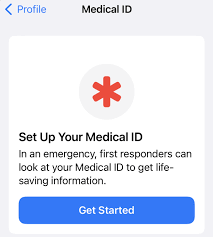
Dear Ms. Smartphone: I should probably wear a medical ID because I have a rare blood type and am diabetic. But I am in my twenties and not wanting to be so public about this. I’ve heard that the Apple watch can store medical information for me and that would be a plus. But why doesn’t someone put this feature on phones? Ajesh
Dear Ajesh: You are actually in luck since phones running the Apple iOS of 13.5 or later have adopted this storage system, just like the watch. Now this vital information can be shared with emergency workers without needing to unlock your phone. If you were incapacitated there’s a backdoor, provided you set it up in advance.
Technically, it’s not a back door at all. It’s a tiny message that appears on the lock screen once you enable the feature. When the link is clicked, it will display a full screen of information for medical providers or first responders. You provide as much information as you want, perhaps your blood type and notes on diabetes condition. There is a place to add the names and addresses of people to contact, in case of emergency (ICEs). Android phones have this capability too. On a Pixel 7 phone open settings, and find the safety and emergency option. Some android models will require that you download an app that can bypass the locked screen.
Easy to Set Up:
It’s easy to set up this information on any phone, but you have to remember to keep it updated if conditions change. Naturally, the entry point for an iPhone begins with the Health App. But, it is not the same input as the health records that your medical provider or doctor sends. This is under your control and kept locally on your phone. When you set up the information for the first time make sure that you also toggle the button that supports enhanced emergency calling. Otherwise it will not work. Once it is set up correctly you will see the medical alert reminder on the left hand side of your home screen, on the page where you enter your password, or as a toggle where you go to power the phone off. It just depends on your Iphone model and iOS. On the Android phone access will generally be under the Emergency/SOS toggles.
The key here is that the rest of the phone remains locked, so your personal emails, passwords, and other data remain secure. Some people find that there is a privacy conflict: it will expose the names of close friends or family members to reach (the ICE) in case of an emergency. That sounds useful, but if you want to be incognito, this set up is not a good idea. Anyone who has access to your phone also has access to this list of ICEs and medical notes. On the other hand, it’s a win/win if you lose your phone and a kindly stranger takes steps to return it.
Ever Present?
Medical ID is not new and the Apple watch (and Android version) already provide this shortcut. As you mentioned, many people still wear necklaces or bracelets that describe their condition and needs for first responders. More high-tech versions of the jewelry have QR codes, or are subscription based and can access your full medical record.
Despite the technology, there is still an advantage to sticking with the jewelry, or having the redundancy of both the jewelry and the Medical ID on the phone. Sometimes you will forget and leave your phone at home, or you will be present at events where it is bad etiquette to bring one along. Worst case, if you were to fall or be in a car accident, the device might fly out and not be recovered. The phone might stop working. So, like everything electronic, it is not fool proof. More significantly, I have heard that paramedics and first responders often do not look to phones for Medical ID alerts- the feature is relatively new. Alternatively, they may be risk averse and concerned that you may have borrowed someone else’s device or the information is not up to date. So they have to start with basic blood work and testing on their own.
For day to day use, it seems Medical ID will bring you some peace of mind. It may not replace the medical bracelet that you don’t want to wear, but it should come close to replacing the little card of information people used to carry in their wallets. Over time, the paramedics and first responders may consider it to be as essential.
